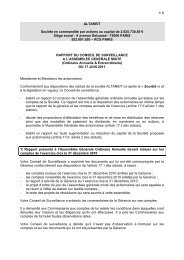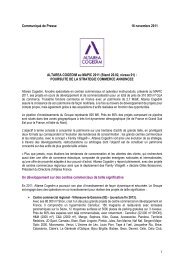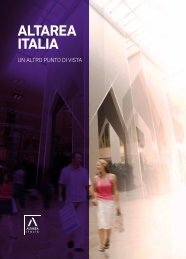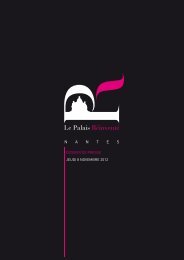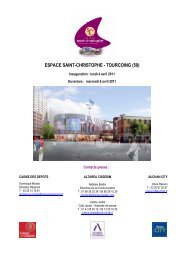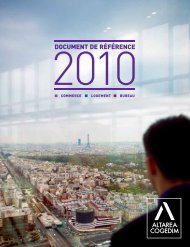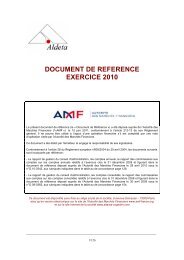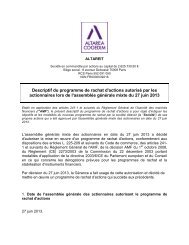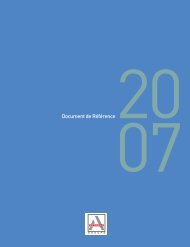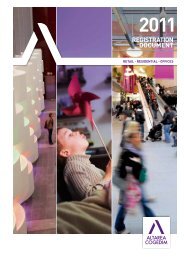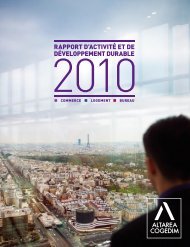Annual report 2008 - Altarea Cogedim
Annual report 2008 - Altarea Cogedim
Annual report 2008 - Altarea Cogedim
Create successful ePaper yourself
Turn your PDF publications into a flip-book with our unique Google optimized e-Paper software.
Employees in both UES ALTAREA and UES <strong>Cogedim</strong> receive<br />
health, disability, and life insurance benefits.<br />
6.6. Training<br />
ALTAREA complies with the French law passed in 2005 on<br />
the employees’ right to training.<br />
Employees were offered 6,073.5 hours of training, or an<br />
average of 8 hours per employee.<br />
In <strong>2008</strong>, ALTAREA invested the equivalent of 2.27% of its<br />
payroll expense in training programmes for UES ALTAREA<br />
employees and 1.6% for UES <strong>Cogedim</strong> employees.<br />
7. Information that<br />
can affect ALTAREA’s<br />
businesses<br />
or profitability<br />
The ten largest tenants in the shopping centres managed<br />
by ALTAREA accounted for 21.01% of total rental income<br />
(excl. tax) in <strong>2008</strong>. No single tenant accounted for more<br />
than 5% of the rental income.<br />
The ten largest customers in ALTAREA’s residential and<br />
office property business accounted for 27.7% of total<br />
revenue (excl. tax) in <strong>2008</strong>. No single customer accounted<br />
for more than 10%.<br />
8. Competitive<br />
environment<br />
The sections of this registration document containing the<br />
company description and management <strong>report</strong> (Parts I and<br />
III) provide detailed, quantitative information on ALTAREA’s<br />
businesses and services, along with their trends, competitive<br />
landscape, and earnings. The management <strong>report</strong> also discusses<br />
the macroeconomic factors and business cycles affecting the<br />
shopping centre and residential property markets.<br />
9. Risk<br />
factors<br />
ALTAREA is exposed to the following risk factors as a result<br />
of its business activities. However, the company feels<br />
it has the resources to limit these risks and manage the<br />
consequences should they materialise.<br />
Risks related to trends in the property market<br />
ALTAREA operates in several sectors of the property market,<br />
mainly commercial property (mostly shopping centres) and<br />
residential property. The company is exposed to systemic<br />
risks and uncertainties specific to the property market, most<br />
notably its cyclical nature, as well as the risks inherent<br />
to each property asset. The company’s risk management<br />
strategy and measures taken aim to limit the negative<br />
consequences should one of these risks materialise.<br />
However, as demonstrated by the current banking and<br />
financial crisis, abrupt changes in the economic, financial,<br />
monetary, regulatory, political, geopolitical, social, health,<br />
or environmental climate may have a negative impact on<br />
ALTAREA’s businesses, asset values, earnings, development<br />
projects, and investments.<br />
Risk of tenant insolvency<br />
ALTAREA’s ability to collect rental income depends on the<br />
solvency of its tenants. The company carefully reviews<br />
potential tenants before granting any leases, although it may<br />
occur that a tenant does not pay its rent on time or defaults<br />
on its rental payments, which would impact ALTAREA’s<br />
operating income. This could be the case if the current<br />
banking crisis were to escalate into full-blown recession as<br />
this would have a significant impact on consumer behaviour<br />
and create difficulties for tenant stores and retailers.<br />
However, rents are relatively unscathed as tenants fear<br />
eviction and accordingly the loss of their business.<br />
Legal, regulatory, environmental, insurance,<br />
and tax risks<br />
Legal and regulatory risks<br />
ALTAREA must comply with regulations in a variety of areas,<br />
including urban planning, construction, leases, operating<br />
permits, health and safety, the environment, and taxes<br />
(most notably the tax rules governing SIICs). Changes to<br />
any of these regulations could require ALTAREA to adjust its<br />
operations, assets, or business strategy accordingly, which<br />
may have negative consequences on its earnings, asset<br />
values, and expenses, and may slow or halt progress on<br />
some of the company’s property development or marketing<br />
activities.<br />
187



